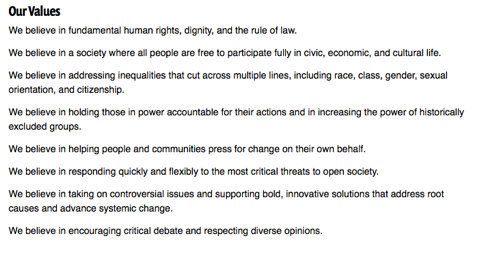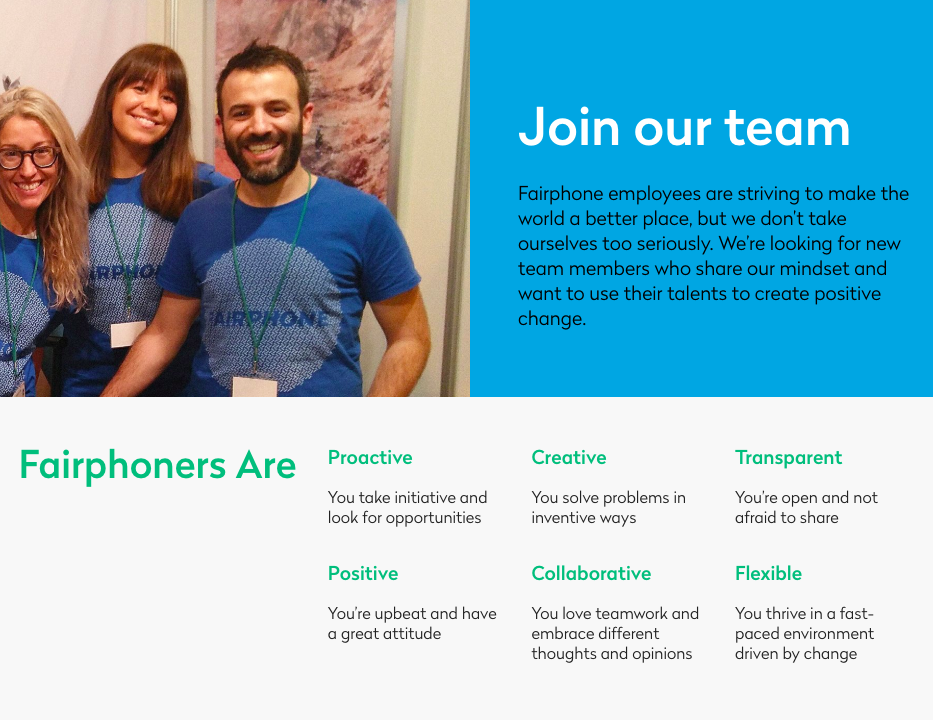Sara was on an extremely bright career path. She was the kind of employee companies dream of. Smart and straight out of business school, she had landed her first job at one of Germany’s largest startups, a food delivery company, from where she was quickly promoted, promoted and promoted again, showing unusual competence in management and putting in long hours. By the age of 30, she had already earned the title of Senior Global Business Manager and was running large teams in Shanghai. Then, whilst in China, when giving one of her many company presentations, somebody asked her what she was most proud of. Personally, in her own career. She paused. Fell silent. Looked at the floor. Eventually, she mumbled an answer about something related to her move to China, ended the presentation and went to sit down.
That was the last presentation she ever held for that company. She handed in her notice a week later. All that Sara could think about when she was asked the question, “What are you most proud of” was, well, nothing. There was nothing that she was really, genuinely proud of in her food-delivery startup job. Despite the numerous achievements, she felt only genuinely proud of her voluntary work. She realised that her personal values did not align with the company, to which she had already dedicated several years of her career, and quit - to start her own social enterprise.
Values are important and this is why
I heard Sara tell this story recently whilst pitching her current business. It’s real. And she is not alone. According to the largest global survey on millennials, 44 % have turned down a job offer because the company’s values did not match their own and 56% have sworn to never work for specific companies because of their organisation’s values.
So let’s just say - if a company doesn’t know what their values are, doesn’t communicate them well or doesn’t live them, then pretty soon, they’re going to be in trouble. Some of the world’s largest companies have been onto this for a while. Paul Pohlmann, CEO of Unilever, embedded a sustainability strategy into the core of the company several years ago. When asked why, he responds that he won’t be able to recruit the top talent in a few years time if he doesn’t. And as Sara shows, even if he could recruit them, he wouldn’t be able to keep them. Putting human values at the core of what your business does is going to be essential to attracting and keeping an engaged workforce (not to mention ensuring that our planet is still around for a few generations to come).
For the non-profit and impact sector, this is a huge opportunity. Smart and talented people are (trying to) leave the private sector in droves. And what are they looking for? Companies and organisations that match their values. And non-profits have definitely got values! So that’s the good news. But what’s the bad news?
The marketplace is getting ever more crowded as more social and sustainable businesses spring up. So it is becoming increasingly hard to get heard. So what does employer branding mean for non-profits and impact companies? I’ll give you a clue. It’s still values.
The value breakdown
So what is values-based employer branding? It’s inward, outward and bottom up. Values are, on the one hand, outward facing. They are your vision and mission. They are your raison d’etre. They are the common beliefs that you, as a company or organisation, share about the world and how you want to change it. Let’s call these the outward values, or o-values. It’s pretty important that these more or less stay the same for the long-term and are defined by the management. O-values are essential to keeping the company and team on track and act as a basis for defining strategy.
- O-Values
- O-Values are, on the one hand, outward facing. They are your vision and mission. They are your raison d’etre. They are the common beliefs that you, as a company or organisation, share about the world and how you want to change it.
The O-Values of the Open Society Foundation:
But there are other values too. And these are just as important. These are your inward facing ones. These are the values that govern how you work together, within your team, to achieve what you have set out to achieve. They may well be connected to your outward-facing values but they are not the same. And they may well change over time. In fact, they probably should, as your organisation hopefully grows and develops. Let’s call these the i-values.
- I-Values
-
These are flexible and evolving values that govern how you work together, within your team, to achieve what you have set out to achieve. They may well be connected to your outward-facing values but they are not the same.
i-values are often buzzwords such as flexible, diverse and inclusive. But what do these words really mean? The answer is that they mean a lot of different things to different people. One person’s understanding of flexible might be that you can come and go from the office when you want. For another person it means being able to do home office once a month. For somebody else, it might have nothing to do with your attendance in the office. So in communicating your company’s values, you need to be as concrete as possible. Use case studies and stories, anecdotes and testimonials, as well as photos and videos, to illustrate how these values are truly lived.
Take an example from Netflix. They have created a 100-page deck about how their values are defined and lived. Big companies such as Netflix put their success largely down to having closely defined both their i-values and o-values. But it is just as important to differentiate between them. And to talk about the right ones, at the right time, with the right people. Often they get mixed up. Potential funders probably don’t need to know about your i-values. But potential employees definitely need to know about both.
Time to put your values where your mouth is
For once, it’s time for the commercial sector to look to the impact sector when it comes to talking about values. The impact sector is leading the way on revolutionising employer branding and talking about their values at multiple touchpoints. After all, non-profits often can’t compete on monetary grounds with many companies from the private sector, so they need to get creative, and they are.
Companies such as Nesta, Oxfam, and Fairphone have their values posted very prominently on their careers pages. You can’t overlook them. The bonus of communicating these i-values here is that it acts as a filter for applicants. If applicants can, in advance, get a feeling for whether they are going to fit into the bubble (note - we are talking about fitting in here on the basis of values and not skin colour or gender or anything else which might lead to less diversity), then they will be able to make a considered decision about whether to apply. And recruiters know that they are getting the best candidates.
Bottom-up employer branding and how to do it
Of course, it is not about just writing down the i-values and putting them on the wall or on the website. The first step, and potential hazard, is defining them. How this usually happens? The managing director or board of a company decides they need (new) values and asks the HR Manager to come up with them. Or, better still, tells the HR department what they are.
In our work with organisations, we have found time and again that this is the worst possible way of coming up with company values that are actually authentic. The management team is often so far detached from the rest of the team, that they don’t have an accurate idea of what the company values really are. And imposing anything on people from above generally does not lead to a sense of ownership in any case.
Which is why we at tbd* recommend, and assist organisations, to do Bottom-Up Employer Branding. The employees should come up with the values, not the management. If what they come up with perturbs the management so much, then this is a great way of recognising that there is fundamental discordance that should be tackled at a deeper level. If everybody is pretty much aligned, then you’re all good to go. The employers have full ownership of their own i-values and everybody is more likely to carry these into their daily work.
Because living the values. That’s what it’s all about at the end of the day. How is anybody, whether inside or outside the company, supposed to know what the values are if they are not lived? Showing them on the website with photos or videos is a great start. Potential applicants who are already interested enough to be on the website will see them and get a great feel for the company. But what about the candidates who don’t know about you yet? That’s why it’s important to get out and about.
Platforms such as tbd* are a great place to demonstrate your brand via an organisation profile or through engaging content. In terms of content, Medium is another great spot or if you can pitch an article to an industry magazine, then even better. We are not talking about advertorials here. Authentic and meaningful content that engages your potential employees will have them beating down the door.
That’s exactly what happened to Lisa Jaspers, founder of fair fashion label Folkdays, when she started talking on more panels at events. Quite unexpectedly - she was actually looking to increase her brand awareness with customers in mind - she started receiving a LOT of really excellent unsolicited job applications. “The best employees I have had have come through this method. They are the ones who truly understand the business, our values and are deeply invested in making the company a success”. It helps of course, that Lisa is an outstanding advocate for fair consumption and public speaker. Maybe that’s not you. But identify the people in your company who are, and use them!
Even if you don’t get a chance to hold a keynote, being at career fairs and relevant conferences is important. But don’t just show up with some flyers like everybody else. Offer an insight into your values through your stand. And if you get to create a workshop or do some other kind of interactive element, even better. At the recent Female Future Force event by EditionF, Google didn’t have a recruitment stand, they exhibited with their “ZukunftsWerkstatt” or “Workshop for the Future” - a training programme in digital education. For sure, they were there on the lookout for great employees, but they did so by promoting their commitment to education. Apparently, they are on the lookout for employees who share their values too.
Some valuable advice
Last but not least, a cautionary tale: The FlatTummyCo, a company with the self-proclaimed mission to “empower women to lead a healthier lifestyle”. When they recently launched their latest product: a sugar lolly that is marketed as an appetite suppressant to girls and young women by none other than the Kardashians, their ex-employees were the first to go to the media. And they went hard. In all the national newspapers, like The Guardian: “We ex-employees are all quite close … Everyone’s just kind of, ‘Ugh, we were a part of that’. Why is no one calling out the company? This isn’t about them. It’s the company that’s the problem.” If you proclaim to have values, which you don’t live, in fact directly contradict, you are going to find yourself some pretty angry ex-employees. in the age of social media, this is something you can’t afford.
Whether you are private sector, public sector or impact sector, you need to understand the values that you represent outwardly, your o-values, as well as the values you represent inwardly, within your team - your i-values. And not only do you need to know them, you need to communicate them and live them.
Want to know how we can help your company with your employer brand? Send an email to naomi@tbd.community.











